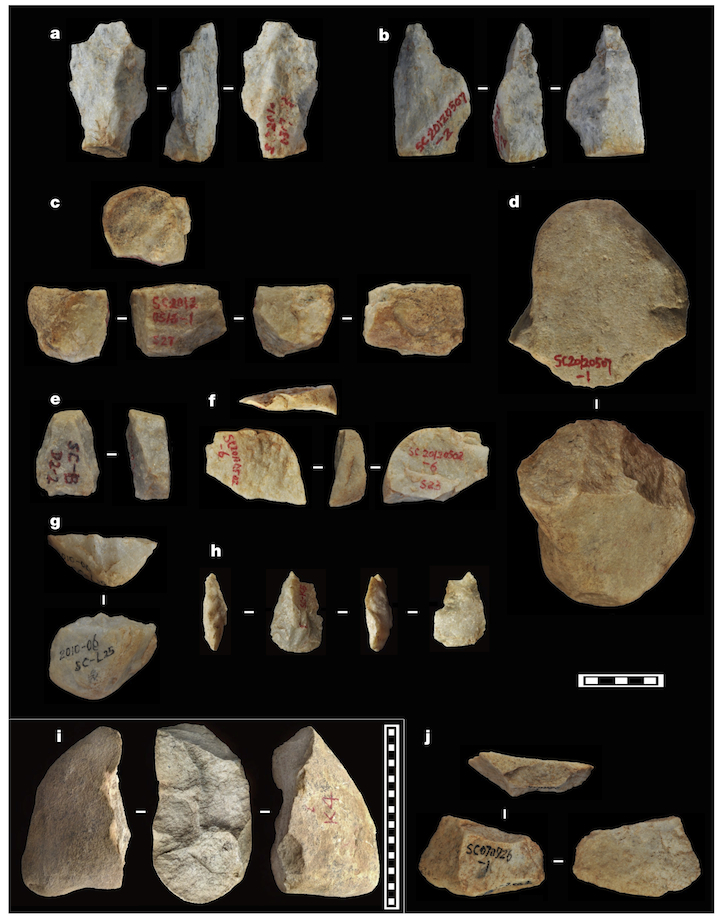Reported by SONG Jianlan
How our ancestors evolved and emigrated have long been heatedly disputed and pursued, and scientists over the world have been working hard to reconstruct the emigrating history of early humans by identifying and dating ancient sites of human habitation.
Approximately dated to about 1.77–1.85 million years ago (Ma), a site in Dmanisi, Georgia, was widely agreed to be the earliest skeletal and artefactual evidence for human occupation outside Africa. It is closely followed by several sites in Asia, including a site in Yuanmou, Yunnan, China. Two incisors from this site, believed to be of Homo erectus, are dated to about 1.7 Ma. In summer 2018, Dmanisi lost its title to a site on the Loess Plateau in China, however, as the result from a new dating jointly made by scientists from CAS and University of Exeter, UK.

The landscape and loess–paleosol section of the Shangchen Paleolithic locality recently found by the joint team. The discovery here indicates that human beings might have emigrated out of Africa earlier than formerly believed. (Credit: GIG & IVPP)
Led by Prof. ZHU Zhaoyu from the CAS Guangzhou Institute of Geochemistry (GIG), Prof. HUANG Weiwen from the CAS Institute of Vertebrate Paleontology and Paleoanthropology (IVPP) in Beijing, and Prof. Robin Dennell from the University of Exeter, UK, the joint team discovered a new human habitation site in the Paleolithic strata of Shangchen locality in Lantian county on the southern Loess Plateau, China. They examined samples and artefacts from a largely continuous paleosol/loess sequence containing 17 artefact layers, and dated the lowest artefact-yielding layer to about 2.12 Ma. They analyzed 96 artefacts unearthed from the strata, and determined that their ages ranged from about 1.26 Ma to about 2.12 Ma.

Selected artefacts found in situ in layers S27–L28 (2.09–2.12 Ma), L27 (1.95–2.09 Ma), L25 (1.73–1.80 Ma) and S23 (1.59–1.65 Ma) from the Shangchen Paleolithic locality. (Credit: GIG & IVPP)
This new age makes Lantian overrun all other human habitation sites to become the oldest outside Africa.
Lantian caught the eye of paleoanthropologists very early. It came into light in the 1960s, when a Homo erectus cranium was unearthed from the Gongwangling locality in Lantian county by IVPP scientists. The discovery excited the whole paleoanthropological world. The cranium was later named “Lantian man,” while its age has been kept in clouds, because the complicated geological environment there makes it very hard to accurately decide the age of the strata. It was once dated to about 1.15 Ma, and this remained unchanged until very recently, when Profs. ZHU and HUANG’s team updated the age to about 1.63 Ma in 2015.
This age is now further updated by the new result from Shangchen locality, which is near to Gongwangling; and this surprisingly old age indicates that we might need to re-examine the origin and emigration of early humans.
Highlighted in this research is its interdisciplinary background, particularly the integration of stratigraphic, paleoanthropological, paleo-geomagnetic and paleo-climatic methods, and the key role played by the loess sequence previously established by outstanding geologists represented by late Prof. LIU Dongsheng (Liu Tungsheng), a CAS Member.
As commented by Prof. Andrew P. Roberts from Australian National University, this impressive work established the age as well as the paleo-climate and environment background of the earliest human habitation site outside Africa, and has important implication to the understanding of human evolution.
References
1. Zhaoyu Zhu*, Robin Dennell*, Weiwen Huang, Yi Wu, Shifan Qiu, Shixia Yang, Zhiguo Rao, Yamei Hou, Jiubing Xie, Jiangwei Han, Tingping Ouyang, Hominin Occupation of the Chinese Loess Plateau since About 2.1 Million Years Ago. Nature 559, 608-612 (Published: July 11, 2018). doi: 10.1038/s41586-018-0299-4
2. Zhaoyu Zhu*, Robin Dennell*, Weiwen Huang*, Yi Wu, Zhiguo Rao, Shifan Qiu, Jiubing Xie, Wu Liu, Shuqing Fu, Jiangwei Han, Houyun Zhou, Tingping Ou Yang, Huamei Li, New Dating of the Homo Erectus Cranium from Lantian (Gongwangling), China. Journal of Human Evolution 78, 144-157 (Published: January 01, 2015). doi: 10.1016/j.jhevol.2014.10.001.

